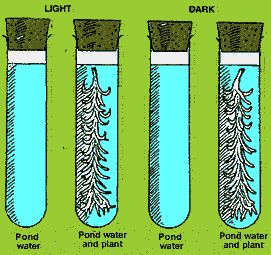Photosynthesis and Respiration
A Balance
Introduction
It is well known that during periods of sunlight plants undergo photosynthesis, consuming carbon dioxide and producing glucose and oxygen. What is not clear to a great number of students is that at the same time plant undergo cellular respiration and produce carbon dioxide.
Green plants trap light energy and transform it into chemical energy by the process of photosynthesis. During this process plants use solar energy to incorporate carbon dioxide and water into sugar molecules. Glucose is the source of energy for virtually all cellular functions. The chemical energy of glucose is transferred to ATP molecules(official energy carriers in cells) during aerobic respiration, and carbon dioxide and water are released. It is possible to demonstrate that green plants take in carbon dioxide during photosynthesis and give off carbon dioxide when photosynthesis is not taking place. When carbon dioxide dissolves in water carbonic acid is formed according to the equation below
Carbon dioxide + Water <=> Carbonic Acid
Phenol red is an indicator which changes colour when the pH of water changes.
When the water is acidic the colour is yellow and when not acidic (alkaline)
the colour is pink.
Water plants, such as Elodea, absorb carbon dioxide from
the surrounding water and return their gaseous wastes to it. The
production and uptake of carbon dioxide by water plants can be shown in the experiment outlined below using phenol red in the water.
If the carbon dioxide concentration in the water decreases the solution will change to pink.
If the carbon dioxide concentration in the water increases the solution will change to yellow.
While neutral solutions of phenol red appear orange.
Materials
4 x test tubes with stoppers; 2X test tube racks; pond water;
phenol red indicator; bottle of soda water; ammonia solution; elodea.
Procedure
Number the test tubes1-4.
Add 5 mL of soda water to each tube
Add concentrated phenol red solution to 100 mL The colour of the water will depend on the quality of your pond water, it should be orange. If its not use drops of ammonia solution or soda water to get the colour to orange.
Fill each tube 4/5 full with the orange water. Leave just enough room for the stopper to fit tightly in the test tube as shown below.
To test tube 2 and 4 place a piece of elodea. The amount of elodea should be the same.
Place the stoppers firmly on the tubes so that they are sealed off from the
air.
Place tubes 1 and 2 in a brightly lit area (by the window ledge) and tubes
3 and 4 in a dark cupboard and leave them for 24 hours.
Record the colour of the indicator in each tube into the table below after 24 hours.
| Test tube | Initial colour | Final colour |
| 1 | Orange | |
| 2 | Orange | |
| 3 | Orange | |
| 4 | Orange |

Figure 1
1) What is the purpose of tubes 1 and
3? Explain.
2) Under what conditions do you expect the indicator to change to pink?
Does this happen in any of the tubes? Can you explain how this is a
result of the processes going on in the plant?
3) Under what conditions do you expect the
indicator to change to yellow? Does this happen in any of the tubes?
Can you explain this is a result of the processes going on in the plant?
4) What would you expect to happen if you reduced
the light intensity? How could you test your hypothesis?
5) What effect do you think different colours of light
have on the plant when compared with the result in white light? Propose
a hypothesis and then design an experiment which tests
this hypothesis. Remember to work out the dependent and independent variables.
6) What general conclusions can you make from the data you have
collected?
7) What changes or improvements can you suggest
which would increase your confidence in your conclusions from this experiment?